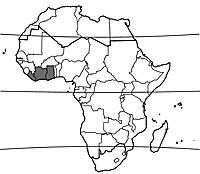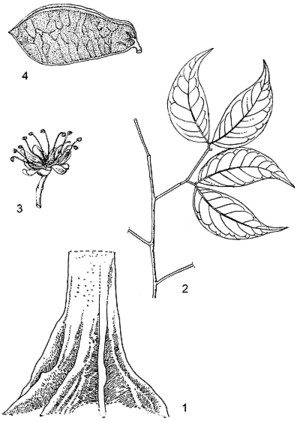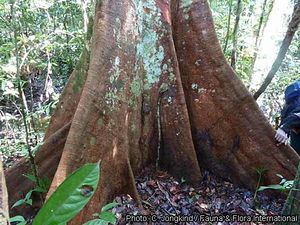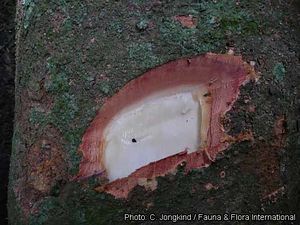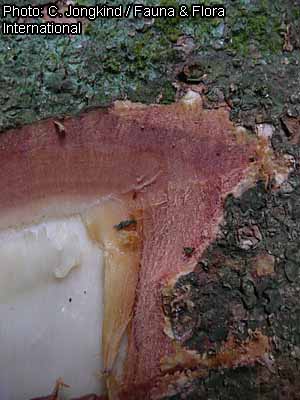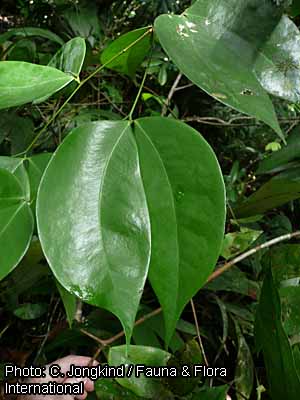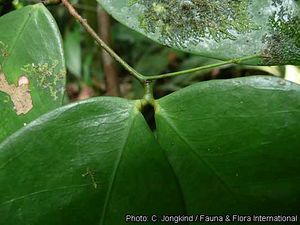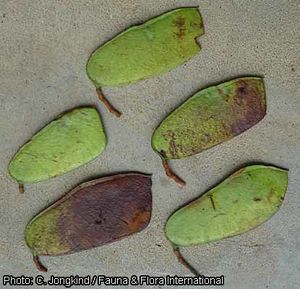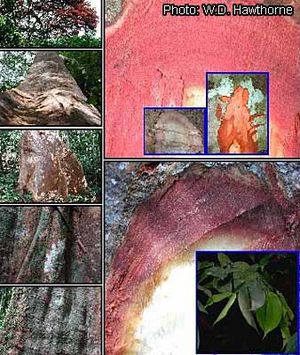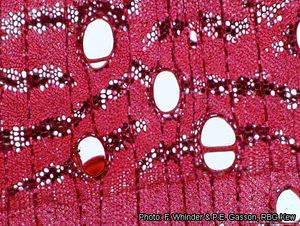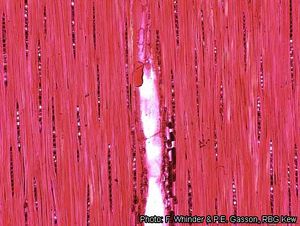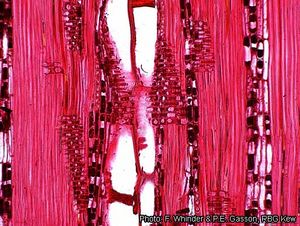Introduction |
Cynometra ananta Hutch. & Dalziel
- Protologue: Fl. W. trop. Afr. 1(2): 331 (1928).
- Family: Caesalpiniaceae (Leguminosae - Caesalpinioideae)
Origin and geographic distribution
Cynometra ananta is restricted to West Africa, where it occurs from Liberia east to Ghana.
Uses
The wood, known as ‘apomé’ or ‘ananta’, is suitable for heavy construction, heavy flooring, bridge building, exterior joinery, interior trim, ship building, vehicle bodies, mine props, poles, railway sleepers, sporting goods, toys, novelties, agricultural implements, pattern making and turnery.
Production and international trade
The wood of Cynometra ananta is used locally and only rarely traded on the international market.
Properties
The heartwood is reddish brown with darker streaks, and distinctly demarcated from the 2.5–7.5 cm wide, yellowish to pinkish brown sapwood. The grain is usually interlocked, texture fine.
The wood is heavy, with a density of 910–1000 kg/m³ at 12% moisture content. It air dries slowly with a tendency of checking and end splitting. Drying should therefore be done with care. The rates of shrinkage are moderately high, from green to oven dry 5.2% radial and 9.3% tangential. Once dry, the wood is not very stable in service.
At 12% moisture content, the modulus of rupture is 126–187 N/mm², modulus of elasticity 14,700–17,840 N/mm², compression parallel to grain 72–83 N/mm², cleavage 18.5–19.5 N/mm, Janka side hardness 11,700 N, Chalais-Meudon side hardness 8.5–14.8 and Janka end hardness 12,940 N.
The wood is difficult to saw and work, and has severe blunting effect on cutting edges and saw teeth; the use of tungsten-tipped cutting edges is recommended. In planing operations a 15° cutting angle is recommended to obtain a good finish, and cutting edges should be kept sharp. Pre-boring is needed for nailing and screwing. The corrosion rate of iron and steel in the wood is high. The wood glues moderately well and can be stained and polished satisfactorily requiring little filling. It turns well. The steam bending properties are moderate. The wood is durable, being resistant to termite and Lyctus attacks, but occasionally liable to pinhole borer and longhorn beetle attacks. The heartwood is resistant to impregnation with preservatives, but the sapwood is moderately permeable.
Some imidazoline alkaloids have been isolated from the leaves.
Description
- Evergreen medium-sized to fairly large tree up to 35(–45) m tall; bole branchless for up to 18 m, straight to twisted, often angular and knotty, up to 120 cm in diameter, with thin plank buttresses up to 3(–4.5) m high; bark surface irregularly flaking with small scales, grey with yellowish to reddish marks, inner bark fibrous, reddish, becoming reddish brown upon exposure, exuding a reddish resin; crown rounded or widely spreading, heavily branched; twigs glabrous, with lenticels.
- Leaves arranged spirally, paripinnately compound with 1 pair of leaflets; stipules triangular, c. 1 mm long, caducous; petiole 0.5–1 cm long, rounded; petiolules 2–4 mm long; leaflets opposite, sickle-shaped, 3.5–15 cm × 1–5 cm, acute to acuminate at apex, thin-leathery, glabrous.
- Inflorescence an axillary or terminal panicle up to 10 cm long, short-hairy, with densely crowded flowers; bracts small.
- Flowers bisexual, nearly regular, whitish; pedicel c. 0.5 cm long; sepals 4(–5), c. 4 mm long, reflexed; petals 5, free, obovate, 3–5 mm long; stamens 10, free, 5–7 mm long; ovary superior, c. 1 mm long, with stipe c. 0.5 mm long, hairy, 1-celled, style 3–4 mm long.
- Fruit an obliquely oblong to obovate, flat pod 8–12 cm × 4–5 cm, with short stipe, short-pointed at apex, smooth and brown, dehiscent with 2 woody, twisting valves, 1–2-seeded.
- Seeds rounded to elliptical, flat, 2–2.5 cm long, pale brown.
- Seedling with epigeal germination; hypocotyl 3–9 cm long, epicotyl 4–18 cm long; cotyledons 1.5–2.5 cm long, thick and fleshy; first 2 leaves opposite, with 2 leaflets, subsequent leaves alternate.
Other botanical information
Cynometra comprises about 90 species and occurs in the tropical regions of the world. Approximately 25 species can be found in mainland tropical Africa and about 10 in Madagascar. Tropical Asia and tropical America have about 25 species each.
Cynometra megalophylla
Cynometra megalophylla Harms, a small to medium-sized tree up to 20 m tall with bole up to 100 cm in diameter, is also restricted to West Africa, occurring from Côte d’Ivoire east to Nigeria, mostly along rivers. Its reddish brown, heavy, hard and durable wood is used for poles, posts and frames in house building. Bark decoctions are used in traditional medicine to treat kwashiorkor, and leaf decoctions to treat measles and chickenpox. Cynometra megalophylla has been suggested to be useful for reafforestation of swampy areas.
Cynometra vogelii
Cynometra vogelii Hook.f. is a small tree up to 10(–20) m tall with bole up to 100 cm in diameter, occurring from Senegal east to Nigeria. Its reddish brown, hard wood is locally used for tool handles; it is also used as firewood. The foliage is fed to cattle. The seed is reportedly edible.
Anatomy
Wood-anatomical description (IAWA hardwood codes):
- Growth rings: 2: growth ring boundaries indistinct or absent.
- Vessels: 5: wood diffuse-porous; 13: simple perforation plates; 22: intervessel pits alternate; 23: shape of alternate pits polygonal; 24: intervessel pits minute (≤ 4 μm); 29: vestured pits; 30: vessel-ray pits with distinct borders; similar to intervessel pits in size and shape throughout the ray cell; 42: mean tangential diameter of vessel lumina 100–200 μm; 46: ≤ 5 vessels per square millimetre; 47: 5–20 vessels per square millimetre; 58: gums and other deposits in heartwood vessels.
- Tracheids and fibres: 61: fibres with simple to minutely bordered pits; 66: non-septate fibres present; 69: fibres thin- to thick-walled; 70: fibres very thick-walled.
- Axial parenchyma: (76: axial parenchyma diffuse); (77: axial parenchyma diffuse-in-aggregates); 80: axial parenchyma aliform; 82: axial parenchyma winged-aliform; 83: axial parenchyma confluent; 85: axial parenchyma bands more than three cells wide; (86: axial parenchyma in narrow bands or lines up to three cells wide); (89: axial parenchyma in marginal or in seemingly marginal bands); 92: four (3–4) cells per parenchyma strand; (93: eight (5–8) cells per parenchyma strand).
- Rays: 96: rays exclusively uniseriate; 97: ray width 1–3 cells; 104: all ray cells procumbent; (106: body ray cells procumbent with one row of upright and/or square marginal cells); 115: 4–12 rays per mm.
- Storied structure: (118: all rays storied); (120: axial parenchyma and/or vessel elements storied); (122: rays and/or axial elements irregularly storied).
- Mineral inclusions: 136: prismatic crystals present; 142: prismatic crystals in chambered axial parenchyma cells.
Growth and development
Older trees have large, widely spreading buttresses and spreading roots, making establishment on shallow soils and slopes more easy. Shedding of old leaves is immediately followed by new flushes, which are initially brilliant red. In Liberia trees flower in September–October, in Côte d’Ivoire in October–December. In Liberia, Côte d’ivoire and Ghana fruits ripen in December–January, in Côte d’Ivoire also in June–July. The fruits are explosively dehiscent, dispersing the seeds over short distances.
Ecology
Cynometra ananta occurs mainly in humid evergreen forest, only occasionally in moist semi-deciduous forest. It is most abundant in regions with an annual rainfall of more than 1500 mm and a dry period of less than 4 months. It usually occurs on sandy soils, but in Côte d’Ivoire it has been recorded to prefer humid, even slightly swampy soils.
Propagation and planting
Seedlings and saplings are often abundant near mother trees. They are shade tolerant, but in Liberia it has been reported that saplings of more than 2 m tall are uncommon. It seems that regeneration is better in logged-over forest. There are about 650 seeds per kg, and the germination rate is high within 15 days after sowing.
Management
Locally Cynometra ananta has gregarious stands and may even be semi-dominant. In forest in Liberia it has been reported to occur at an average density of 0.3 boles of more than 60 cm in diameter per ha, but locally it is much more common, in some areas having an average density of 3 large boles per ha. In Côte d’Ivoire and Ghana it is also locally abundant.
Harvesting
Cynometra ananta is not easy to cut because of the often large and high buttresses and the hard and heavy wood. In Ghana the recommended minimum bole diameter allowed for felling is 70 cm.
Genetic resources
Cynometra ananta does not appear to be liable to genetic erosion at present because it occurs locally in large stands and does not seem to be subject to selective logging. However, with the ongoing fragmentation of evergreen forest in West Africa, monitoring of populations is recommended.
Prospects
The hard and heavy wood and the often poor bole shape of Cynometra ananta are serious drawbacks for commercialization efforts. However, its fair regeneration rate in natural forest, and the high natural durability and high resistance to abrasion of the wood offer possibilities for commercial timber production for special purposes such as heavy-duty flooring, as long as long rotation cycles are acceptable. Research is recommended on the growth rates under favourable conditions and appropriate management systems.
Major references
- Bolza, E. & Keating, W.G., 1972. African timbers: the properties, uses and characteristics of 700 species. Division of Building Research, CSIRO, Melbourne, Australia. 710 pp.
- Burkill, H.M., 1995. The useful plants of West Tropical Africa. 2nd Edition. Volume 3, Families J–L. Royal Botanic Gardens, Kew, Richmond, United Kingdom. 857 pp.
- de Koning, J., 1983. La forêt de Banco. Part 2: La Flore. Mededelingen Landbouwhogeschool Wageningen 83–1. Wageningen, Netherlands. 921 pp.
- Holmgren, M., Poorter, L., Siepel, A., Bongers, F., Buitelaar, M., Chatelain, C., Gautier, L., Hawthorne, W.D., Helmink, A.T.F., Jongkind, C.C.H., Os-Breijer, H.J., Wieringa, J.J. & van Zoest, A.R., 2004. Ecological profiles of rare and endemic species. In: Poorter, L., Bongers, F., Kouamé, F.N’. & Hawthorne, W.D. (Editors). Biodiversity of West African forests. An ecological atlas of woody plant species. CAB International, Wallingford, United Kingdom. pp. 101–389.
- Oteng-Amoako, A.A. (Editor), 2006. 100 tropical African timber trees from Ghana: tree description and wood identification with notes on distribution, ecology, silviculture, ethnobotany and wood uses. 304 pp.
- Sallenave, P., 1955. Propriétés physiques et mécaniques des bois tropicaux de l’Union française. Centre Technique Forestier Tropical, Nogent sur Marne, France. 129 pp.
- Sallenave, P., 1964. Propriétés physiques et mécaniques des bois tropicaux. Premier supplément. Centre Technique Forestier Tropical, Nogent-sur-Marne, France. 79 pp.
- Takahashi, A., 1978. Compilation of data on the mechanical properties of foreign woods (part 3) Africa. Shimane University, Matsue, Japan. 248 pp.
- Voorhoeve, A.G., 1979. Liberian high forest trees. A systematic botanical study of the 75 most important or frequent high forest trees, with reference to numerous related species. Agricultural Research Reports 652, 2nd Impression. Centre for Agricultural Publishing and Documentation, Wageningen, Netherlands. 416 pp.
Other references
- Arbonnier, M., 2004. Trees, shrubs and lianas of West African dry zones. CIRAD, Margraf Publishers Gmbh, MNHN, Paris, France. 573 pp.
- Aubréville, A., 1959. La flore forestière de la Côte d’Ivoire. Deuxième édition révisée. Tome premier. Publication No 15. Centre Technique Forestier Tropical, Nogent-sur-Marne, France. 369 pp.
- Cooper, G.P. & Record, S.J., 1931. The evergreen forests of Liberia. School of Forestry, Yale University, Bulletin 31, New Haven, United States. 153 pp.
- de la Mensbruge, G., 1966. La germination et les plantules des essences arborées de la forêt dense humide de la Côte d’Ivoire. Centre Technique Forestier Tropical, Nogent-sur-Marne, France. 389 pp.
- Hall, J.B. & Swaine, M.D., 1981. Distribution and ecology of vascular plants in a tropical rain forest: forest vegetation of Ghana. W. Junk Publishers, the Hague, Netherlands. 383 pp.
- Hawthorne, W.D., 1995. Ecological profiles of Ghanaian forest trees. Tropical Forestry Papers 29. Oxford Forestry Institute, Department of Plant Sciences, University of Oxford, United Kingdom. 345 pp.
- Hawthorne, W. & Jongkind, C., 2006. Woody plants of western African forests: a guide to the forest trees, shrubs and lianes from Senegal to Ghana. Kew Publishing, Royal Botanic Gardens, Kew, United Kingdom. 1023 pp.
- Irvine, F.R., 1961. Woody plants of Ghana, with special reference to their uses. Oxford University Press, London, United Kingdom. 868 pp.
- Kryn, J.M. & Fobes, E.W., 1959. The woods of Liberia. Report 2159. USDA Forest Service, Forest Products Laboratory, Madison, Wisconsin, United States. 147 pp.
- Kunkel, G., 1965. The trees of Liberia. Field notes on the more important trees of the Liberian forests, and a field identification key. Report No 3 of the German Forestry Mission to Liberia. Bayerischer Landwirtschaftsverlag, München, Basel, Wien. 270 pp.
- Neuwinger, H.D., 2000. African traditional medicine: a dictionary of plant use and applications. Medpharm Scientific, Stuttgart, Germany. 589 pp.
- Normand, D. & Paquis, J., 1976. Manuel d’identification des bois commerciaux. Tome 2. Afrique guinéo-congolaise. Centre Technique Forestier Tropical, Nogent-sur-Marne, France. 335 pp.
- Taylor, C.J., 1960. Synecology and silviculture in Ghana. Thomas Nelson and Sons, Edinburgh, United Kingdom. 418 pp.
Sources of illustration
- Oteng-Amoako, A.A. (Editor), 2006. 100 tropical African timber trees from Ghana: tree description and wood identification with notes on distribution, ecology, silviculture, ethnobotany and wood uses. 304 pp.
- Taylor, C.J., 1960. Synecology and silviculture in Ghana. Thomas Nelson and Sons, Edinburgh, United Kingdom. 418 pp.
- Voorhoeve, A.G., 1979. Liberian high forest trees. A systematic botanical study of the 75 most important or frequent high forest trees, with reference to numerous related species. Agricultural Research Reports 652, 2nd Impression. Centre for Agricultural Publishing and Documentation, Wageningen, Netherlands. 416 pp.
Author(s)
- C. Essien, Forestry Research Institute of Ghana (FORIG), University P.O. Box 63, KNUST, Kumasi, Ghana
- A.A. Oteng-Amoako, Forestry Research Institute of Ghana (FORIG), University P.O. Box 63, KNUST, Kumasi, Ghana
Correct citation of this article
Essien, C. & Oteng-Amoako, A.A., 2011. Cynometra ananta Hutch. & Dalziel. [Internet] Record from PROTA4U. Lemmens, R.H.M.J., Louppe, D. & Oteng-Amoako, A.A. (Editors). PROTA (Plant Resources of Tropical Africa / Ressources végétales de l’Afrique tropicale), Wageningen, Netherlands.
Accessed 31 May 2025.
- See the Prota4U database.

